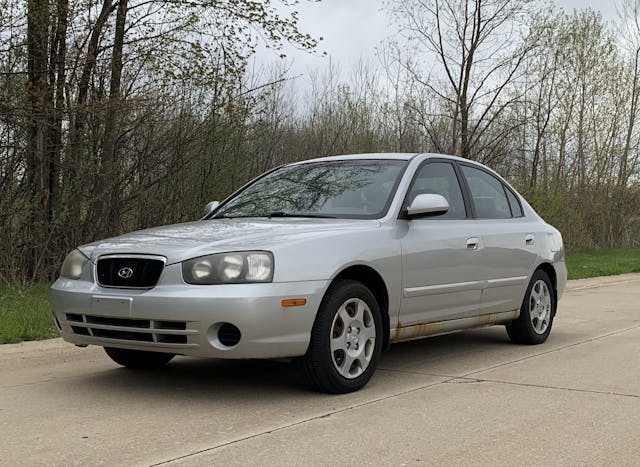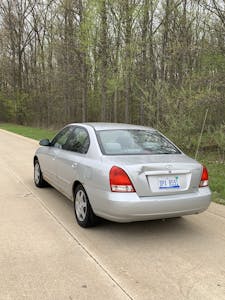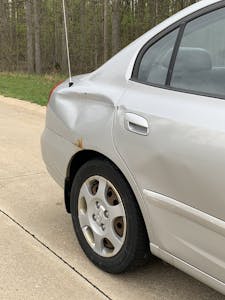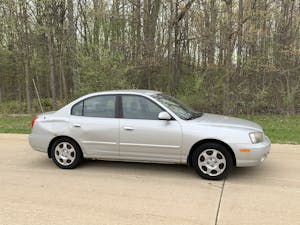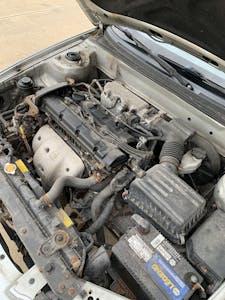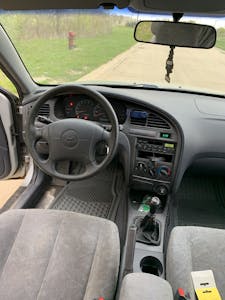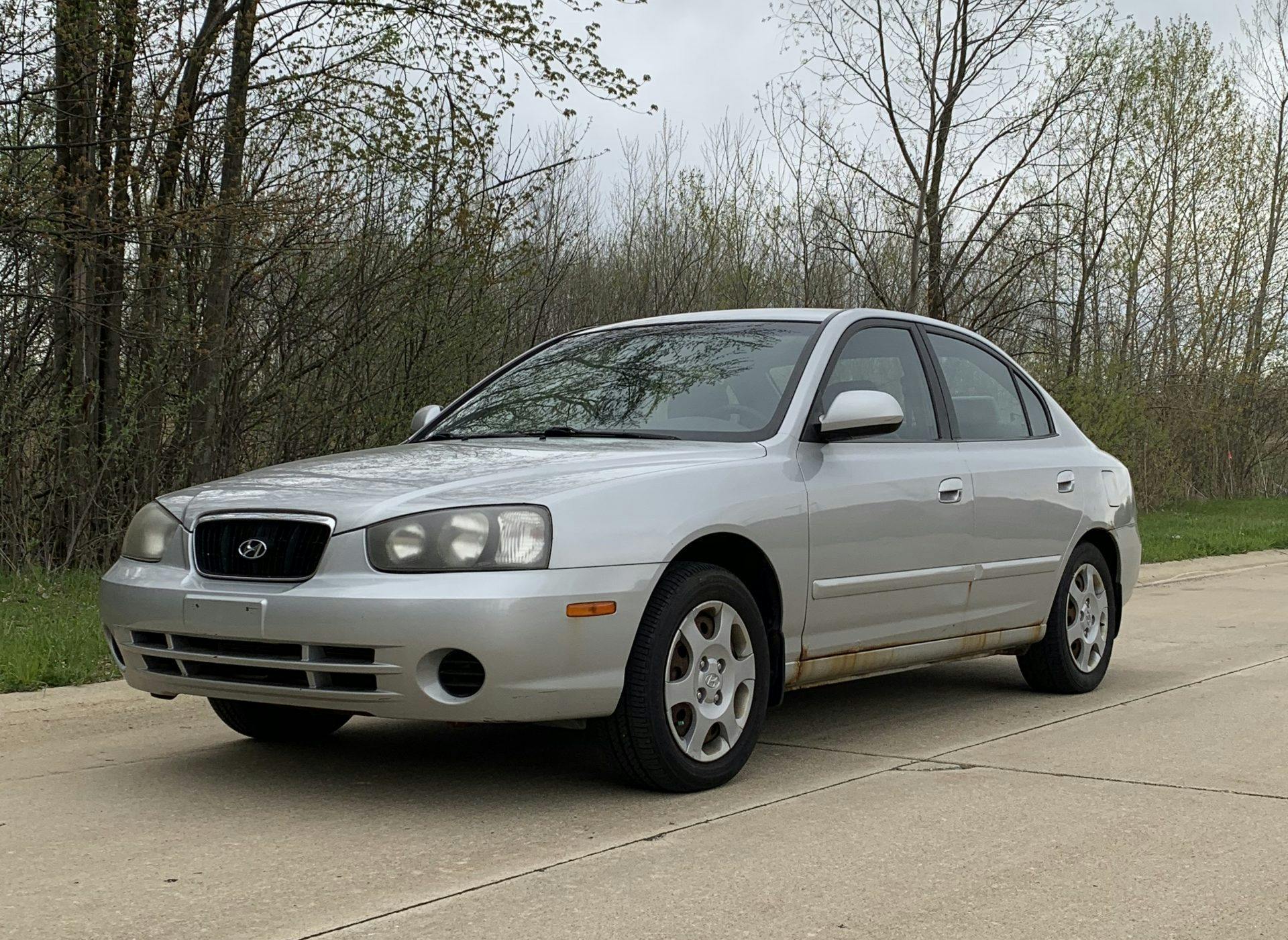Media | Articles
In defense of the Terrible Car
The 2003 Hyundai Elantra GLS pictured here cost me $1200. That was about $400 too much, but that reality wouldn’t become apparent until a couple months into ownership. The Hyundai is now sitting in a junkyard, ready to offer its parts to fellow clunkers before the inevitable trip to the crusher and god knows what after. The car was as forgettable as last Tuesday, virtually dripping mediocrity from the moment it arrived in my life until the rainy day, some three years later, that we parted ways.
I kind of miss it.
Actually, “miss” might be the wrong word. The car came to the rescue when I needed help. So let’s just say its departure left… an empty space.
When the clutch on my 1987 Porsche 924S decided to take the winter off several years ago, I found myself with little time, little budget, and two options: fix the 924—a time-consuming, costly process in the best of conditions—or find an extremely low-cost beater for the season. Before you get ideas, this picture of a wealthy man not wanting to risk his expensive toy, remember that the 924S is not the most beloved of Porsches. It’s a good machine but humble, lower-value, and betrays a lot of Audi and Volkswagen under the skin. A writer’s sports car, in other words.
I loved the Porsche, so the choice was obvious: hold the salt.
Marketplace
Buy and sell classics with confidence
The Elantra popped up for sale locally, a much-abused, manual-transmission Michigan car that looked the part. The massive dent in the right rear quarter was evidence of an unfortunate side-swipe, and most of the body seams were rusting. The exterior sheet metal held more scratches and dings than horsepower.
Things got off on the wrong foot. Shortly after I brought the car home, the driver’s door-handle mechanism broke in a strange spot, turning egress into a corny four-step process: roll window down, reach out and pull exterior door handle, jab inside panel with left knee to open, roll up window from inside. The repair was too expensive, and I couldn’t conjure the motivation to dive in and fix it myself; uninspiring cars have a way of sapping one’s DIY spirit. So the rest of the car’s life was spent polishing that window switch to a dull shine. Winter mornings with frosty windows were… complicated.
If I’m honest, I grumbled for a bit. I may have let certain important repairs hold a little. For various reasons, the car had exactly one working brake—the right rear drum—so hurried stops were never in the cards. So long as you drove with a little extra caution, the brakes were fine, if not the safest idea. Then the snow came. That first Christmas, slick conditions and some overly enthusiastic use of that lone brake drum precipitated a terrifying spin on the highway. The Hyundai and I met a guard rail.
In retrospect, it could have been much worse; the Elantra simply bounced off the rail and carried on. The experience made me reconsider my approach to safety, and I had a shop repair the car’s stoppers that week. My meager bank account grew a bit more meager, but we had brakes.
Then something changed.
That encounter with the guard rail proved liberating—gifted damage I couldn’t afford to fix, I realized that I could afford to stop caring about the Hyundai’s exterior. As long as the Elantra didn’t break mechanically, its appearance didn’t matter. Mind you, it was a mess to start, and it didn’t get better. A friend—definitely a friend—once drop-kicked the front fender during a St. Patrick’s Day party because, as he said, the car “looked at me funny.” The little Hyundai took it on the chin.
One of the funny things about beater ownership is how you come to care about the car’s details. This works but that doesn’t; this looks nice, but that bit needs work. The guard rail evaporated all that. Allowing the Elantra’s cosmetics to drop off the list of items I worried about each day returned to me a sliver of peace of mind—perhaps the most undervalued commodity for a young person of thin financial means. The little Hyundai was also cheap to maintain. In the four years of ownership, two things went wrong: The car bricked its starter once, an easy repair I performed with a friend. The front struts also checked out one spring, but I sent the car to a shop for that job—on a car of this caliber, few people wake up excited to do battle with rusty hardware.
Nor did the Hyundai ever leave me stranded. The Elantra saw daily use for two years, faithfully chauffeuring me around Ann Arbor, Michigan, and occasionally even braving the life-or-death sweepstakes that passes for Detroit’s highway network. Next to the rattle-clunk Dodge Journeys and rusty, first-gen Cadillac CTSes, it blended right in.
Thankfully, this form of automotive exile wasn’t forever. After saving for a bit, I was able to afford a much better ride, buying an old Lexus in Portland, Oregon and road-tripping it back to the Mitten state. But even as the Lexus assumed daily duties, the Hyundai remained. I couldn’t bring myself to sell it. There was no logical justification save a slight hesitancy to foist such an awful car on anyone else—most buyers at the Elantra’s price point are happy to have anything on wheels, but saddling someone else with the car just didn’t feel right.
But wasn’t it just so reliable? Yes, even after sitting for months at a time, the Hyundai would fire right up, first crank. That aspect would have been great for someone in need. The rust, on the other hand, would not have been. When I put the Elantra in the air for a serpentine belt replacement last March, there were a lot of signs that the car’s vital parts were nearing the end of their lives.
My fiancee and I were planning to move to Traverse City later that spring. My wife-to-be is a woman of patience, but she made it clear that the rusty Hyundai would not be coming with us. For the first time in my ownership of the car, I worried about it—should I try to sell? Maybe donate the car?
Going against my earlier judgement, I decided to list the Hyundai for sale, for $1000. Given the car’s condition, I didn’t want to sell to someone desperate, but thankfully, the first party to express interest didn’t seem too pressed. During a pre-purchase inspection, a shop notified me that rust had done more damage than I’d thought: one of the metal brake lines was on its last legs and would need replacement.
The repair estimate was enough to scuttle any ideas of a sale. I could not, in good conscience, sell the car knowing there was risk of brake failure. Especially not with the Hyundai’s abysmal crash-test rating. (Don’t google crash videos from this generation of Elantra. The results are… well, you’re opening another tab right now, aren’t you? Don’t say I didn’t warn you. Thankfully, the company’s modern stuff is miles better.)
That pretty much sealed it. At the end of May, a week before our move, I called a local junkyard and said that I’d be bringing by my silver bucket of yuck for permanent parking. It was pouring rain the day I drove down to the yard. In a rather unceremonious end to the saga, I left the title and keys in the junkyard’s dusty office, then picked up a small check for scrap. That was that.
Almost two months have passed. Do I want the Hyundai back? Not at all—I’m glad to have one less thing on my plate. But I’m also grateful for what it offered. If the car sits on my conscience now, it’s only because it never did that during my ownership. Sometimes, the best car isn’t the one that accelerates the hardest or gets the best fuel economy. It’s just the one that doesn’t ask anything of you. Even if the thing remains terrible in its silence.
